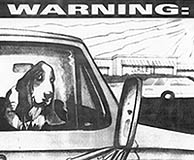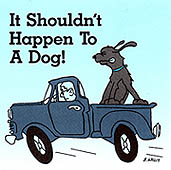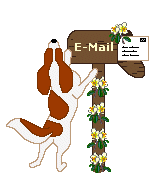There are many parts involved in the total care of your family dog. Some things are easy to overlook, even with the best intentioned people. We occasionally forget about cleaning the ears, trimming the toenails, and even cleaning the teeth! It's easy to assume that the crunchy kibble our dogs eat will 'cleanse' the teeth while they chew. (The Cavaliers are dainty, thorough eaters; but never mind that my Labradors inhale their dinner, burp in a completely rude manner, and then look around for more!) That is not always the case, and unless one makes it a habit of prying open those mouths - avoiding the cheerful kissing attempts on their parts - and looking at the health of the teeth, we might miss a plaque build-up, or gum disease/gingivitis.
Plaque is composed of bacteria, saliva proteins, and food debris; and - as it accumulates on the teeth, and in between the gums and the teeth - it will cause the irritation, swelling, and redness that makes up the periodontal disease. If left unchecked, the grooves deepen, forming "pockets" (much as your own dental care provider gauges during each visit), which allow the bacteria to cause more damage to the gums, ligaments, and bone tissues that hold the teeth in place. One especially scary consideration is that the bacteria from the periodontal infection has a clear shot to other vital organs. Breeds which are susceptible to heart problems (as are the Cavaliers) should be extra cautious; organs with the highest blood flow are at the most risk. There is a clear link in humans between oral disease and heart disease; which can significantly shorten lives - it stands to reason that this should be a concern with our dogs as well.
Signs to look for include bad breath (think about how your teeth and breath smell after a long day without brushing!); a yellow-brown crust of plaque at the base of the teeth, at the gum line; swollen and red gums; bleeding when your dog chews on a hard toy, or his meal; pain when eating or chewing, or even being touched in the mouth; a decreased appetite might indicate pain with chewing; and loose or missing teeth. Hopefully you will have avoided any of these problems because you are already brushing your dog's teeth! Be a good friend to your best friend: if you see any of these signs, get thee to the veterinarian...!

Dr. Dan Wasmund of
Woodside Veterinary Hospital was kind enough to allow me to use these wonderfully descriptive pictures of the canine mouth and teeth!
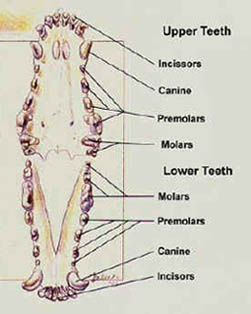
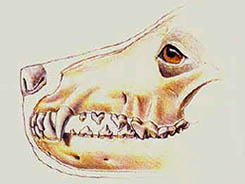

I would like to present a pictorial essay on how important it is to engage in regular oral hygiene for your dog, by showing what happens if it is ignored. Without pointing any fingers (we all let things slip past our notice!), I'd like to use Jasmine as an example. She joined our family at 3½ years of age, and her teeth were not in good shape. There was a bad build-up of plaque on her teeth, and a few of the teeth had decay and/or discoloration. If you have a queasy tummy, forgive some of the photos, they are graphic! Up close and personal, that's me and my camera..

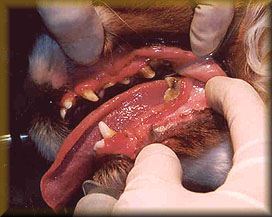
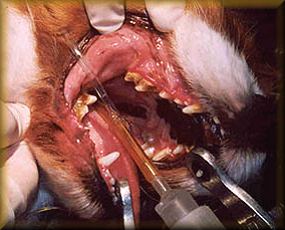
These first two photos show the condition of Jasmine's teeth before starting the cleaning; and this is after having been on anti-biotic medication for 10 days, which really helped with the inflamation and infection in her gums. Jasmine's teeth and gums are not as bad as some they've seen, the Vet Techs and Vets assure me! But this is my baby, I'm only concerned about
her! Soooo, we begin. (The tubing in her mouth is for the anesthetic, the dog must remain "asleep" for the procedure.)

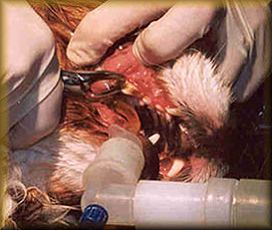
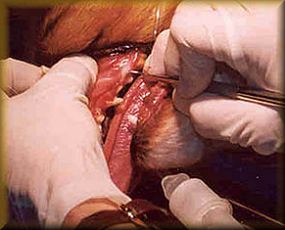
The photo on the left shows the plier-like instrument used to break and scrape off the plaque when it's really thick and tough. The right photo shows the regular instrument used to scrape, or "scale", the teeth.

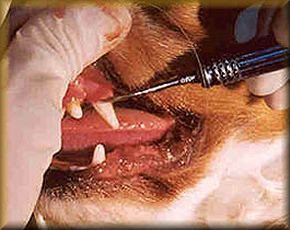
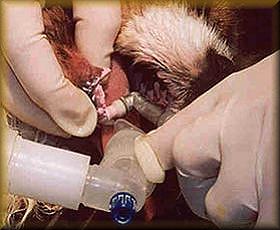
The photo on the left shows the "power scaling"; using the ultra-sonic instrument to remove the plaque and also irrigate the gums. (It was similar to watching a super-dooper power washer for your driveway!) The next step (right photo) was the polishing of the teeth, using the same type of instrument your dental hygienist uses on your teeth. In fact, the cleaning "paste" smelled like berries - the same type my dentist used with my children!

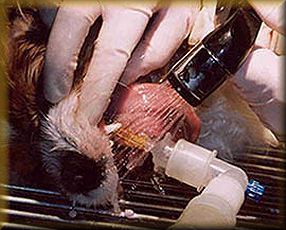
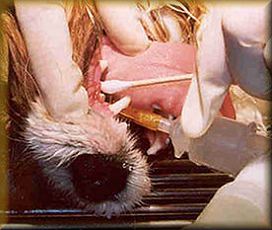
After the teeth are rinsed and then dried, fluoride is applied. Preventative measures are important!



A few minutes later the Veterinarian again checks the teeth. She demonstrates periodontal probing to identify periodontal pocketing, or the extent of disease. In Jasmine's case there is one tooth (photo on the left) that has decay on the anterior and interior, and the root pulp is exposed. The damage is too extensive to save the tooth, so it had to come out. The photo on the right shows the sad remnants of the tooth and root. Fortunately the two other teeth that were in question will remain, but we must keep watch on them. Two incisors (one each top and bottom) are loose, and they, too, must be watched.

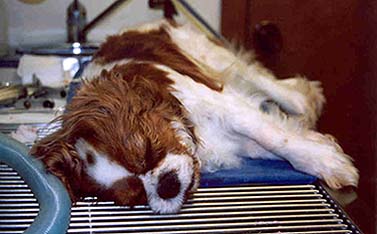
After it's all done - after having her teeth cleaned, and had the micro-chip inserted (good thing she was asleep, no need to feel
that big ouch!), and her
hips x-rayed (and, yes, they looked wonderful, no dysplasia here!) - she's ready to awaken from the anesthetic. Even if it's a safe anesthetic (Isoflurine in her case) it is still risky to anesthetize a dog - and some breeds are at higher risk. That alone is a good reason to have a regular routine of dental care: to avoid having to go through this process. Cost is another factor to consider; don't most of us try to keep our pet care budget within reason?!? A canine toothbrush and toothpaste will cost you well under $20; procedures such as Jasmine's teeth cleaning, polishing, flouride treatment, and extraction can cost anywhere from $150 to $500. That's a big
bite out of your wallet! (besides the indignity of just everyone being able to see a lady when she's
not at her best!!)


And when it's all done, she can be happy and healthy
 and SMILE!
and SMILE!

| Many thanks to the Barclay Hills Veterinary Clinic for allowing me to photograph the entire teeth cleaning procedure, and for enduring my questions and strobes!! |
























 and SMILE!
and SMILE!

